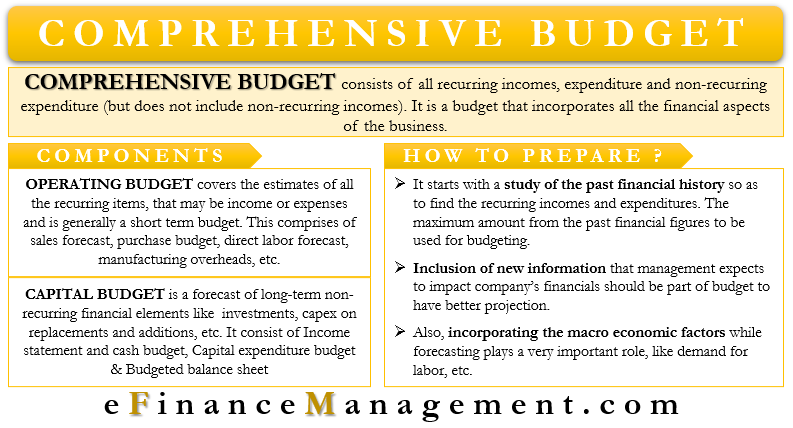What is a Comprehensive Budget?
A comprehensive budget consists of all the recurring income and expenditure and non-recurring expenditure. It does not include non-recurring income as, according to the principle of conservatism, income that is not certain to be earned should not be accounted for. It is also known as the “total budget or master budget.” Such a budget is a new enterprise financial management method and has gained popularity in recent years.
Recurring income consists of interest income, rentals from the property, etc. Recurring expenditure may be in the form of salaries, interest on loans, electricity bills, other administrative expenditures, etc. An example of a non-recurring expenditure can be the repair or replacement of major machinery or its part, purchase of durables for business, etc. In other words, as the name suggests, it is a budget incorporating all the financial aspects of the business.
Recurring and non-recurring income and expenditure are also differentiated on the basis of their time frames. Recurring items repeatedly occur within a short span of time. Hence, they require short-term planning. On the other hand, non-recurring items do not happen frequently and, thus, require long-term planning. Both categories of items require different business strategies with different goals.
Components of a Comprehensive Budget
There are two primary components of a comprehensive budget based on recurring items for short-term goals and non-recurring items for long-term goals.
Operating Budget
The operating budget is usually a short-term budget. Moreover, it covers the estimates of all the recurring items, which may be income or expenses. It is easy to do their forecasting and counting. This budget comprises:
Also Read: Operating Budget
- Sales forecast and sales budget
- Closing inventory budget
- Purchase budget
- Production budget
- Cash budget
Capital Budget
The capital budget is a forecast of long-term non-recurring financial elements such as investments, capital expenditure on replacements and additions, etc. The financial budget portion consists of the following:
- Income statement
- Capital expenditure budget
- Budgeted balance sheet
How to Prepare a Comprehensive Budget?
As per the discussion above, a comprehensive budget comprises two components – An operating Budget and past financial history.
In the above paras, we have discussed what an operating budget is and what all it incorporates. Now let us discuss the second component:
Past Financial History
The past financial history provides a perfect picture of what to expect in the near future in the budget period. There are many recurring expenses that occur only once or twice every year, like insurance premiums. Hence, a proper study of financial history is important for at least a year. This will help to find these recurring incomes and expenditures.
There may be a few items that occur every year. But their frequency and the amount may not be constant. In such cases, the maximum amount to be spent in the budget period should be included in the budget. However, in the case of income, this amount should be the minimum, or the company may even exclude it as per the principle of conservatism.

Incorporating New Data
Any new information that the management expects to impact the company’s financials should be part of the budget other than the past financial history. The more information a company has or sources, the better the projections or the budget will be.
Also Read: Financial Budget
For example, if the company is looking to increase sales in the coming budget period, proper budgeting for purchasing raw materials, production, and increasing manpower will have to be done. A good budget will incorporate all this new data beforehand to properly set financial requirements and goals and avoid any hindrances at a later stage.
Incorporating the Macro Factors
The operating budget should incorporate the macro factors of the economy too, and not just the internal factors affecting the business. For example, the demand for labor will be low in an economy facing a recession while the supply will be high. In such a situation, the labor rates are not expected to go up in the near future. Interest rates normally stay constant or even fall in a recessionary phase in the economy. Moreover, the demand for goods and services may also fall for some time. A good budget should take these macro factors into account too to give a fair view of the financial expectations in the future.
Capital Budget
Capital expenditures and investments are a part of the long-term planning and budgeting procedure. Income that remains after the operating budget, generally the free cash flow, is of use to build or purchase capital assets such as machinery, land, etc.
Internal Factors
Factors internal to the organization are generally in the control of the management. If the business is looking to expand, it will need to produce more. It will have to buy more plants and machinery to be able to do so. Hence, this sort of investment is usually predictable and should be incorporated into the budget. The future goals should be the driving force for the budget.
External Factors
On the other hand, external factors affecting the business are not in anyone’s control and are unpredictable to a large extent. No one knows if the economy will be in an expansionary phase or if it will contract if there will be inflation or deflation after a few months. Therefore, one cannot account for these situations in the budget.
Summary
Comprehensive budgeting, a phenomenon that evolved over the years; however, has got good traction in recent years. It is a convenient accounting and management tool. Comprehensive budgeting makes the job of decision-making for managers very easy. It covers every aspect of the business, thus having a very broad scope. Moreover, it helps the management in its control function and checks for any variations and deviations from the planned budget.
Read more about other Types of Budgets.

